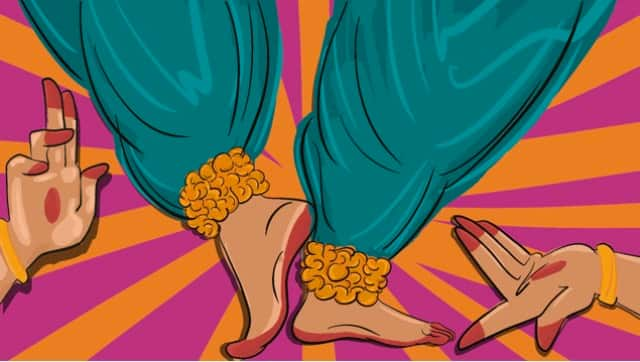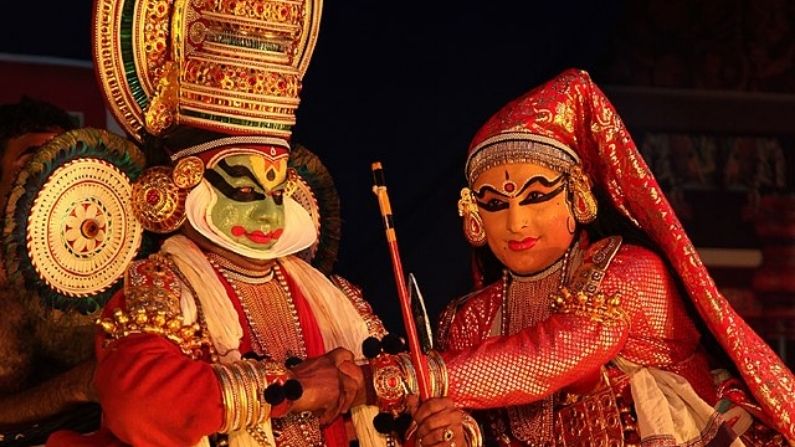Indian classical dances – celebrated across the globe for their enriching and mesmerising virtuosity – can be traced back to centuries-old ways of storytelling, performed as much for entertainment as for the spread of cultures and knowledge. Each classical form is built upon layers of complex histories that often converge at the intersection of culture, art, politics and even conflict, readjusting its structures and boundaries in the light of revolution and reform. Consequently, varying styles of the art form find new homes and families to become gharanas, yet other dance forms are added to the ever-dynamic definition of what constitutes as classical. This series is an attempt to reacquaint the connoisseur and engage the uninitiated in the vibrant facets of the eight classical dance forms of India by offering a glimpse into the history, performance, attire, comportment and musical accompaniments that give colour, form and rhythm to these cultural legacies. In the eighth essay, an exploration of Kathakali’s spectacular storytelling practice. * An almost operatic rendition of mythological lore, Kathakali is remarkable for its enigmatic performance style and a distinguished quality of storytelling that is magnificent and theatrical in equal measure. The ancient performing art is rooted in natya dharmi abhinaya (theatre art) and employs a movement grammar and a musical rhythm distinct from most other classical dance forms to tell stories of love, war, devotion and conflict in a manner so powerful that it generates a rather heady and hypnotic atmosphere among the gathered audiences. And within its name lies the very essence of the art form for it is a profoundly evolved and majestic performance style that tells a katha (story) through a kali (play). With origins in Kerala, Kathakali along with Kathak, Bharatnatyam and Manipuri was among the first dance styles to ever enter the canon of classical dances of India as identified by the Sangeet Natak Akademi. Yet, what distinguishes the art form most prominently from nearly every other classical art is its historical origins in courts and theatres, as opposed to temple precincts which were the home of most classical arts in ancient and medieval India.
Performed predominantly by male artists, Kathakali has always been a performing art meant to tell stories. During the medieval periods, a Kathakali concert began at dusk in the brilliant glow cast by the kalivilakku, a huge bell-like metal lamp with wicks dipped in coconut oil. The recital would continue well into the early hours of the morning and a sequential performance would even carry on for multiple nights. Today, a concert is as brief as three to four hours, presenting only vignettes from the great epics like Mahabharata and Ramayana instead of elaborate episodes found in the Attakatha or lyrical plays composed especially for Kathakali. But what makes Kathakali so dynamic is its inherent urge to tell stories making the dance-drama adaptable to diverse narratives. As such, in its contemporary practice, Kathakali has explored on stage tales by Miguel de Cervantes or William Shakespeare, visible in notable productions like Annette Leday’s Kathakali-King Lear
. Origins in dance-dramas of Travancore and Malabar While much of Kathakali’s movement vocabulary follows the theoretical framework of Bharat Muni’s Natya Shastra, its mudras (hand gestures) are heavily influenced by the Hastalakshana Deepika that has codified 24 different gestures, incorporated also in Kerala’s Mohiniyattam
. Historical narratives present a rather blurry narrative of the practice of this art form in the 16th and 17th centuries but anecdotal evidence hints at Kathakali’s origins in several variations of the dance-drama like Krishnanattam and Ramanattam. Oral histories suggest that Krishnanattam – a dance-drama celebrating the feats of Lord Krishna – flourished under the patronage of the Zamorin ruler of Calicut Sri Manavedan Raja so much so that the neighbouring king of Kottarakkara requested him to send a troupe of performers to his province for a recital. However, when the Calicut monarch declined this request, the enraged king Kottarakkara Thampuran created a new rendition of dance-drama, this one based on the epic poem Ramayana. Composed in Sanskrit, this Ramanattam would in large part go on to inspire the development of Kathakali, evident in the compositions performed by Kathakali artists which to this day largely depict the war between Rama and Ravana.
Kathakali, while broadening its conventional structures to now include female artists in its modern interpretation, has nevertheless sustained as a group performance. This too, is quite unlike most other classical dance forms which in post independent India were refined and structured to fit a solo recital format. In such a group concert, the todayam usually performed behind a curtain called the thiraseela, is followed by the technical set purappadu after which the drummers and musicians take centre stage to perform the melappada. Next comes the tiranokku, that for the first time introduces the characters of the story to the audiences, except for the protagonists and then follows the much-awaited abhinaya or the ilakiattam during which the dancer can delve into a character’s deep-seated anguish, joys and predicaments. It is however in the chodiattam sequence that the artist conforms to the words of a lyric taking the story forward. Through time, many a Kathakali artist have garnered great critical acclaim for their poignant abhinaya such as Kalamandalam Ramankutty Nair known for portraying dark villains like Ravana or Duryodhan and the monkey God Hanuman and Kottakkal Sivaraman renowned for the exploration of the nayika (heroine) and the lasya anga or the softer movements within Kathakali. The artists were remarkable for effectively employing what is one of Kathakali’s stellar attributes, its angik abhinaya. A straightforward gesture of pointing in a particular direction in Kathakali means turning the entire torso towards the path one must look at. Such acting transcends then facial expressions and subtle body language to become a performance that is theatrical, dramatic and larger-than-life. From its ancient performances presented in front of monarchs and royalty to its contemporary recitals on stage, Kathakali maintains in its movement grammar and abhinaya much of its age-old performance aesthetic carried forward generation after generation through the guru-shishya parampara. As such two prominent Kathakali schools continue to produce exponents of this art form, namely the Kalluvazhi style originating in Palakkad that was developed and formalised in Kerala Kalamandalam and the Kidangoor style with roots in Travancore. The art of Kathakali’s costuming Where vachik and angik abhinaya form a critical component of Kathakali, it is the aharya abhinaya or the costuming that actually equips the dance form with a comportment that elevates the entire performance.
Kathakali demands arduous physical and emotional feats from its artists and the costumes only add to the remarkable portrayals of the mythological characters that come alive on stage.
Many Kathakali concerts are thus preceded by a visual experience showcasing how each of these characters with painted faces is readied by skilled make-up artists for the performance. The colours for the make-up are made from rice paste and vegetables, and there are nearly five basic vesham or characters that they are used to denote.
 Know Your Classical Dances. Illustration by Poorti Purohit[/caption] Aishwarya Sahasrabudhe writes about art, culture, books, and entertainment. Currently, she has returned to school to study the intersections between gender, culture, and development. The writer is a Kathak Visharad practicing and performing the classical dance form for over a decade. Read all the
Latest News
,
Trending News
,
Cricket News
,
Bollywood News
,
India News
and
Entertainment News
here. Follow us on
Facebook
,
Twitter
and
Instagram
Know Your Classical Dances. Illustration by Poorti Purohit[/caption] Aishwarya Sahasrabudhe writes about art, culture, books, and entertainment. Currently, she has returned to school to study the intersections between gender, culture, and development. The writer is a Kathak Visharad practicing and performing the classical dance form for over a decade. Read all the
Latest News
,
Trending News
,
Cricket News
,
Bollywood News
,
India News
and
Entertainment News
here. Follow us on
Facebook
,
Twitter
and
Instagram
)